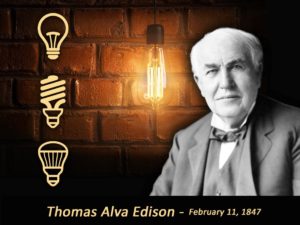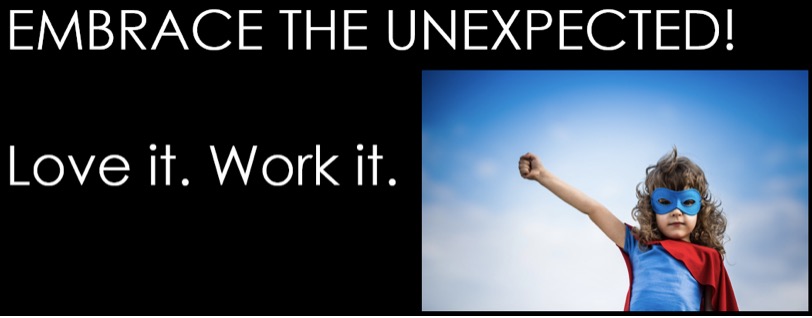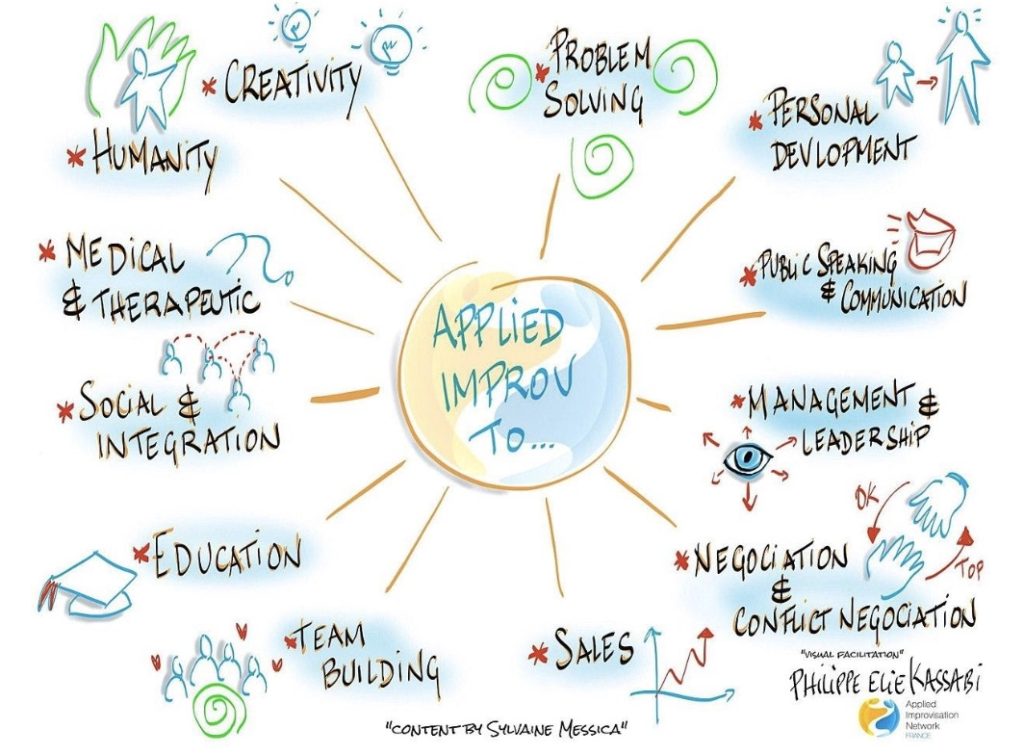How the Antifragile Entrepreneur Can Improve With Improv (Part III)
Sign up for our newsletter
The books
This methodology with 24 steps and 15 tactics was created at MIT to help you translate your technology or idea into innovative new products. The books were designed for first-time and repeat entrepreneurs so that they can build great ventures.

Part 3 of 3—Creative Problem-Solving and Guerilla Skills
“One day I learned that dreams exist to come true. And since that day I do not sleep for rest. I sleep just to dream.”
“Restlessness is discontent and discontent is the first necessity of progress. Show me a thoroughly satisfied man and I will show you a failure.”
 Thomas Edison and Walt Disney are not just America’s greatest creative problem-solvers. They are paragons of all the antifragile entrepreneurial skills we have discussed. Edison is famous for the thousands of “failures” it took to come up with the right filament for his lightbulb. Disney’s businesses failed several times, and he almost went bankrupt in the midst of creating two of his many masterpieces – the film “Snow White” and Disneyland. Indeed, it was only after he lost his first character, Oswald the Lucky Rabbit, to unscrupulous producers that he came up with what would eventually be one of the world’s most recognizable corporate symbols and a cultural icon – Mickey Mouse.
Thomas Edison and Walt Disney are not just America’s greatest creative problem-solvers. They are paragons of all the antifragile entrepreneurial skills we have discussed. Edison is famous for the thousands of “failures” it took to come up with the right filament for his lightbulb. Disney’s businesses failed several times, and he almost went bankrupt in the midst of creating two of his many masterpieces – the film “Snow White” and Disneyland. Indeed, it was only after he lost his first character, Oswald the Lucky Rabbit, to unscrupulous producers that he came up with what would eventually be one of the world’s most recognizable corporate symbols and a cultural icon – Mickey Mouse.
Besides being perfect examples of perseverance, courage, confidence, and leadership, it is important to realize that their curiosity and creativity were not just about finding things to fix – problem-solving. Walt and Tom were especially ingenious at filling needs that had yet to be articulated. There was no such thing as a theme park or any of the many thousands of components that would go into it before Walt figured that families needed a fun way to do things together. Likewise, the “kinetographic camera” and phonograph were examples more of “creative opportunity-grabbing.” Even if you are not creating something revolutionary, though, your creative efforts will be more about improving than fixing.
Remember Bill Aulet’s bullseye description of antifragile entrepreneurs? People who, “grow when exposed to volatility, randomness, disorder, and stressors, and love adventure, risk, and uncertainty.” That description is never more so than when it comes to the creative process. Indeed, the skills are a step up because they aren’t just about weathering the storm and growing from adversity. When you set out to create something out of nothing, or just to improve or fix something, you are taking on the forces of chaos. No roadmap here, folks. But, hey, you love adventure, risk, and uncertainty, right?
There isn’t a roadmap, but there is improvisation – the “unforeseen.” The famed Chicago advertising agency Leo Burnett would not only pay for their creative staff to attend Second City’s improv school but would shell out for their client-service and media folks, too. They knew it wasn’t just about being better presenters, and they weren’t really interested in a bunch of comics hanging around the water cooler. They recognized early on the benefit of all the skills discussed in the previous pieces as well as collaboration, dealing with ambiguity, rewriting the rules, and just basic curiosity – the elements of creative pursuits.
Brainstorming
“I dream, I test my dreams against my beliefs, I dare to take risks, and I execute my vision to make those dreams come true.”
“To have a great idea, have a lot of them.”
 As we have emphasized before, entrepreneurs, possibly against what they suppose is their better judgment, must collaborate. Edison led teams of the finest minds he could find. Disney hand-picked employees from his studio to work on Disneyland and gave them an enviable handle, Imagineers, possibly the largest band of brainstormers ever. These two quotes define the difference in creative problem solving and just problem-solving. This is not logical trial and error, which is just a nice way of saying beat your head against the wall. Gather up as many ideas from various people and perspectives as you can; discuss them and filter them in a positive way, and try them out.
As we have emphasized before, entrepreneurs, possibly against what they suppose is their better judgment, must collaborate. Edison led teams of the finest minds he could find. Disney hand-picked employees from his studio to work on Disneyland and gave them an enviable handle, Imagineers, possibly the largest band of brainstormers ever. These two quotes define the difference in creative problem solving and just problem-solving. This is not logical trial and error, which is just a nice way of saying beat your head against the wall. Gather up as many ideas from various people and perspectives as you can; discuss them and filter them in a positive way, and try them out.
Remember our paragon of creative opportunity-grabbing, the improv troupe? They hone their brainstorming skills into a few seconds of tossing around ideas to meet their audience’s suggestions and expectations. To do that, they must follow some of the same methods of brainstorming we teach at Serious Improv!: no fearing failure; trust each other; be positive; no bad ideas; listen before talking.
 Nobody wants to come up with bad ideas, of course, but that unwillingness “to go bad, go silly, go stupid, go goofy” also can keep you from coming up with good ideas, or maybe a small part of a great idea. So, we have our improvisers stand in a circle and develop one by one an idea for the worst movie ever made. They start with combining two unlikely genres – say, documentary and slasher – then move on to the plot, characters, actors and eventually a really bad title. That’s actually easier than the next exercise where, in groups of three, they state a problem (possibly a real one that is affecting their work environment); then state a really ridiculous solution to the problem; then explain how the ridiculous solution could lead to a real solution. So, if the problem is that people are spending too much time playing internet games, the ridiculous solution is to provide free pop-tarts for everyone. The third person, then, suggests free breakfasts, including pop-tarts, to those who pledge they will only play games on their breaks, or not at all.
Nobody wants to come up with bad ideas, of course, but that unwillingness “to go bad, go silly, go stupid, go goofy” also can keep you from coming up with good ideas, or maybe a small part of a great idea. So, we have our improvisers stand in a circle and develop one by one an idea for the worst movie ever made. They start with combining two unlikely genres – say, documentary and slasher – then move on to the plot, characters, actors and eventually a really bad title. That’s actually easier than the next exercise where, in groups of three, they state a problem (possibly a real one that is affecting their work environment); then state a really ridiculous solution to the problem; then explain how the ridiculous solution could lead to a real solution. So, if the problem is that people are spending too much time playing internet games, the ridiculous solution is to provide free pop-tarts for everyone. The third person, then, suggests free breakfasts, including pop-tarts, to those who pledge they will only play games on their breaks, or not at all.
Those “bad ideas” teach improvisers to have the courage to speak up, and to not prejudge or post-judge ideas, and to deal with “volatility, randomness, and disorder.” At Serious Improv! we then move them on to more constructive brainstorming activities, such as inventing a ride for Disneyland. In small groups, they must not only work together to come up with a name and a detailed explanation of the ride, but they must also report on all the ideas they tossed out, or changes to those ideas, to reach their presentable idea. To teach them to deal with the real world of fickle clients, we sometimes change the marching orders halfway through, so that they must theme their ride around one or more princesses, or a villain. They then must report on how they adapted their old idea to these new parameters, or how they had to junk their original idea altogether.
Then, if they did a great job, they are rewarded with the opportunity of changing that really bad slasher documentary movie they came up with the circle to a really cool movie idea. They must keep as much of the original idea as they can. Interestingly, brainstormers do better with a little instruction or obstructions. Nothing is so daunting to the imagination as “blue sky,” or no restrictions. Often, groups struggling to come up with a good idea for a Disneyland ride will welcome the restriction of making it about princesses or another specific character. The lesson for creative problem-solving is to sometimes impose artificial restrictions to help foster ideas.
Rewriting the Rules
“Hell, there are no rules here – we’re trying to accomplish something.”
 What is especially endearing about this quote is Edison’s attitude, as if it is obvious that rules are antithetical to invention. And, to be sure, to the antifragile entrepreneurial improviser, they are. Rules, along with status quo, ennui, prejudice, dogma, routines, doubts, habits, certainties, fears, and any number of beliefs are the mental blocks between you and the solution/invention/idea you are seeking.
What is especially endearing about this quote is Edison’s attitude, as if it is obvious that rules are antithetical to invention. And, to be sure, to the antifragile entrepreneurial improviser, they are. Rules, along with status quo, ennui, prejudice, dogma, routines, doubts, habits, certainties, fears, and any number of beliefs are the mental blocks between you and the solution/invention/idea you are seeking.
We discussed many of the exercises that help our improvisers overcome their need for rules, etc., in the section on flexibility, which is vital to all improvising. Also, though, is the need to address these mental blocks “head-on” in order to dismantle them. Students in a circle can reveal their pet peeves, which are often rooted in prejudices. They can then talk about “other people’s prejudices” that they have witnessed. Then, perhaps in smaller groups, they can discuss their own habits, or even ruts, that they find themselves in.
Creative people are usually “zaggers,” which is to say, “when everyone else zigs, you zag.” Some zaggers are helped along by an honest discomfort with “trendy” “popular,” or anything involving conformity. We help them along in their zagging by encouraging them to take a different route to work every day, just to open their eyes and to get out of that “route routine.” We also reveal to them that they witness the world at their own height. To open their eyes, we have them stand on a table and/or lie on the floor.
A couple of “zagger” games are especially fun for the improvisers. In order to be “big picture” thinkers, they need to understand when the rules truly don’t apply. So, a “would you rather” game comes in handy, where the participants must think up scenarios in which the question is to follow a certain rule or, better yet, law, or break it in the name of some greater good.
To realize how we are manipulated by movies and media into certain emotional reactions, we use roleplay games where we are put into a cliché scene. We must first play the cliché emotional reaction, then play an opposite reaction. So, when our wife reveals she has driven the car into the swimming pool, first we get angry, then we suggest we leave it there and let the kids swim around it like it is a sunken treasure. In a favorite improv scene, when our kid reveals he is running away from home, we either ask to come along; offer to send some postcards along with him; ask him to drop off that electric screwdriver borrowed from Uncle Ed; or, ad infinitum. Because one of the biggest mental blocks concerns self-image, another fun exercise has us make up parts of our own body that we hate, and explain why. “I have the ugliest toenails. I wear my socks in the swimming pool I am so ashamed.” “Yeah, I know what you mean. The cuticles on my thumbs are so embarrassing, I can’t shake hands with anyone.” “I have too many bumps on my tongue. See?” “I don’t have any hair on my leg where my tights rub them. See?”
Getting Curiouser and Curiouser
“We keep moving forward, opening new doors, and doing new things, because we’re curious and curiosity keeps leading us down new paths.” — Walt Disney
 We have been working our way backward through the “creative process,” to the root of all intelligence, learning, and achievement – curiosity. Some of the previous exercises and games – those designed to open your eyes – can help teach curiosity. Or, rather, inspire it; there is no teaching curiosity. You follow the example of Edison’s mother and send your charge down to the basement with a chemistry set, and see what happens.
We have been working our way backward through the “creative process,” to the root of all intelligence, learning, and achievement – curiosity. Some of the previous exercises and games – those designed to open your eyes – can help teach curiosity. Or, rather, inspire it; there is no teaching curiosity. You follow the example of Edison’s mother and send your charge down to the basement with a chemistry set, and see what happens.
We encourage awareness to our environments; to all kinds of spatial, temporal, behavioral patterns; to methods of observing that which you have seen but not really seen. For instance, students are shown a variety of optical illusions. They must then see, for instance, both the faces looking at each other and the champagne goblet, in that popular illusion. They must be able to go back and forth in an optical illusion to see first one thing and then the other. They can then help others in the class who can’t quite see it.
One favorite is the color game, which we use virtually every day to keep ourselves sharp. It is as simple as closing our eyes, thinking of a color, and then opening our eyes. Amazingly, with little concentration needed, we will see that color in things we never saw before. Besides making us more observant, this exercise is parallel to a method of creative problem-solving: going from a part to the whole. So, if you have to come up with a Disneyland ride about villains, you may want to first come up with villainous characteristics, or, jump ahead to “scary,” and list all of the things that scare you. Then you can either match that too scary things in Disney movies or have the villains do those scary things to your riders, or….
Discover, Explore, and Heighten
“It’s kind of fun to do the impossible.” — Walt Disney
At a point in “Prisoner of Azkaban,” Harry Potter saves his godfather, Sirius Black by finally conjuring the very difficult Patronus charm. Afterward, he confides in Hermione that, because of their time traveling, he knew he could do the charm because he had already done it. And that is the charm in Walt’s quote. He could regard several “impossible” achievements and, maybe once they were accomplished, describe them as fun.
There is one impossible exercise left, impossible because it teaches virtually every antifragile entrepreneurial skill there is. It is called “Discover, Explore and Heighten.” Improv troupes use it to practice their “where,” or being able to visualize a scene out of an empty stage. So, if by their suggestions, the audience has placed me in an elevator, I must first decide the basics of this elevator – what kind of building is it in; is it old-fashioned, glass-walled, super fast? I then can focus in on specific aspects of it: the number of buttons; is the number thirteen missing; is the door not closing, or not opening. All of these specificities, you can see, have many possibilities for a skit or a story. I heighten them by choosing my relationship with any one or all of them. So, I discover that indeed there is no thirteenth floor even though my room number is 1313. So, if there is no 1313, then where did I sleep last night? Well, that accounts for the guy in the other bed snoring all night.
At Serious Improv!, we put you in “a space” and let you tell us what is there. If you are not specific enough, if you haven’t “discovered, explored and heightened” or just “discovered and explored” enough, we will ask you questions to prompt you. Besides opening your eyes, this exercise lets you leverage the most important resource you have – your imagination. Then, once you master this, you can create your own space. One fun exercise is for everyone to mime (maybe with sound effects) the one perfect room in their house, with that one special item that they wish they had. The rest of the audience can play along by guessing what the item is.
The Future
“There’s a way to do it better – find it.” — Thomas Edison
We always ask our students what they have learned. What you may have learned here is the inclination to detect the things in your life that don’t work right the things that annoy you; the things that can be improved; the services, situations, and things that you can possibly move from chaos to order. That is creative problem solving and creative opportunity grabbing. Miscellaneously worthy to note, successful creative antifragile entrepreneurs: rarely do it just for the money; look for best practices; drill down to essences; go wide and go deep in their interests; love change; respond well to pressure, and sometimes even need it; also respond well to the pure calm of a shower, looking at clouds or performing mindless tasks; understand that everything is inherently interesting… to somebody. Oh, and embrace surprise.
And (to bring it back around to the beginning of this series) they don’t give up.
“You may not realize it when it happens, but a kick in the teeth may be the best thing in the world for you.”
“Many of life’s failures are people who did not realize how close they were to success when they gave up.”
“All our dreams can come true if we have the courage to pursue them.”
Mike & Nate at Serious Improv
The authors
Mike Grimshaw & Nate Lee
Mike and Nate's backgrounds cover an impressive array of domains, from founding startups and angel investing, to sales, leadership & management training, advertising, financial strategy, customer engagement, and more. Together, they founded Serious Improv, where they use improv to help businesses and organizations improve the way they work .

The Disciplined Entrepreneurship Toolbox
Stay ahead by using the 24 steps together with your team, mentors, and investors.
How the Antifragile Entrepreneur Can Improve With Improv (Part II)
Sign up for our newsletter
The books
This methodology with 24 steps and 15 tactics was created at MIT to help you translate your technology or idea into innovative new products. The books were designed for first-time and repeat entrepreneurs so that they can build great ventures.

(Part 2 of 3: Opportunity recognition/assessment, resource leveraging/value creation, and building support networks)
“Everything that can be invented has been invented.”
“In my opinion, all previous advances in the various lines of invention will appear totally insignificant when compared with those which the present century will witness.”
“The advancement of the arts, from year to year, taxes our credulity and seems to presage the arrival of that period when human improvement must end.”
The idea that the head of the country’s patent office predicted the end of invention is laughably ironic until replaced by the irony that it was the opposite of how Commissioner Duell actually felt. How then more absurd is the actual prognostication 56 years earlier, also by the head of the country’s patent office. Want some more irony? Samuel F.B. Morse would invent no less than the telegraph in 1844, a year later.
Fortunately for civilization, entrepreneurs are more the Duell types. There is little to nothing that can’t be improved, the entrepreneur must believe. In his piece on Antifragility and the Entrepreneur, Bill Aulet describes entrepreneurship as “an operating model that people can apply… where they are utilizing resources that are not under their control.” Entrepreneurs are eager to plunge into the unknown; antifragile entrepreneurs are the ones who learn and improve from all the travails that the unknown provides.
Process Skills
Even if your entrepreneurial goal is more for your future than the future, dealing with all of the unknowns demands an array of antifragile “process” skills: recognizing opportunities; leveraging resources to develop new products or services (more on this skill in the next article on creative problem solving); conveying your vision, and developing and using a network to get it done.
Again, the microcosm of this process is the sketch that the improv troupe performs. They recognize opportunities in the suggestions from the audience; they mime their resources and rely on the resources of their cohorts to create a scene; they present their idea through a variety of movements, sound effects, and speech; and they move and change and adapt the scene as it progresses in order to convey a “story” and get to a satisfactory conclusion. In addition to the skills we discussed in the previous article—listening, flexibility, embracing surprise, and self-confidence—they rely on teamwork, not fearing failure, using all available objects and resources (which usually means their clothes and body parts, and, if they are lucky, chairs or a hula hoop), and creating the other places, people and objects that they may need.
Teamwork
 Just as listening is universal to virtually all improv exercises, so is teamwork. Even before you build your idea into an organization, you will need to understand that entrepreneurship does not mean going it alone. You may have left a boss behind, but you will need to gather a team of individuals you respect whose skills complement your own. And, you will need to work with them.
Just as listening is universal to virtually all improv exercises, so is teamwork. Even before you build your idea into an organization, you will need to understand that entrepreneurship does not mean going it alone. You may have left a boss behind, but you will need to gather a team of individuals you respect whose skills complement your own. And, you will need to work with them.
Though most improv exercises and games are group efforts, there are some that focus on teamwork. A favorite of our students at Serious Improv! is “Remote Control,” a two-person exercise. The controller makes all kinds of random sounds, animal noises, gibberish, what-have-you; the controlee responds physically, matching various movements to the sounds. Then they switch by having the movement person “control” the sound person.
Exercises can also have a group of improvisers, often in a circle, learning to collaborate. They can build a story one word at a time, or, in typical “Yes… And” fashion, keep adding on to a “Rumor,” one sentence at a time. “Machine” allows the participants to actually feel what it is like to teamwork. In a circle or a line, any number of willing improvisers can together create a machine. One person starts with a simple—preferably mechanical—motion, such as lifting her arm up and down in a chopping motion. The second person must create a motion that works with the first motion. So, he may move his arm from side to side so that it crosses the plane of the chopping motion but then moves out of the way before the arm comes down. Each person does a different motion until everyone is working together. Once they are going strong, they can each add a sound effect. Then, to make things fun (aka surprising), they must reverse the machine. When they have the hang of this, they can start all over with a more objective-driven vending machine or assembly-line machine, one that makes candy or booze or televisions, or…. The beauty of “Machine” is that each person is clearly “working” both as an individual and as part of a whole.
Leveraging Hidden Talents
 One of the greatest and most antifragile entrepreneurs of all time, St. Paul, or Saul of Tarsus, revealed one of the secrets to his organizational abilities in his letter to the Corinthians. He discusses the need for a variety of skills, or spiritual gifts as they have come to be known, and makes it clear that all gifts are of equal importance. (Only recently have psychologists and educators come around to understanding that there are, likewise, many bits of intelligence and many ways to learn.) The lesson here for tomorrow’s entrepreneur is to seek out and truly appreciate the skills, gifts, and interests that make us different.
One of the greatest and most antifragile entrepreneurs of all time, St. Paul, or Saul of Tarsus, revealed one of the secrets to his organizational abilities in his letter to the Corinthians. He discusses the need for a variety of skills, or spiritual gifts as they have come to be known, and makes it clear that all gifts are of equal importance. (Only recently have psychologists and educators come around to understanding that there are, likewise, many bits of intelligence and many ways to learn.) The lesson here for tomorrow’s entrepreneur is to seek out and truly appreciate the skills, gifts, and interests that make us different.
One of the many nice things about being human is that we often have resources, skills and hidden talents that just the right entrepreneurial leader can discover and utilize in somewhat the same way she might utilize other non-human resources. Rather than just have participants “tell” each other what they like to do, one improv exercise, “Rapport,” has two people act out five things they like to do, without speaking. They must also find two things they have in common. (They can also draw their five favorite things, again, without speaking.)
Understanding the likes and dislikes of your fellow workers or your client – what incentivizes them—is also key to the entrepreneurial skill of conveying a compelling vision. Even more important than the presentation skills and being used to being on stage that improv gives you, is knowing who you are talking to. Advertising copywriters often make excellent writers because they are used to visualizing their audience. It is usually handed to them in the marketing strategy: do-it-yourselfers, 25 to 80 years old, men and women in small towns, which means you address your message to Uncle Ed and Aunt Cindy in Springton, Colorado. When convincing others of your vision, do you stress profits or saving the world or job creation or….? If you know your audience, you know the answer.
Leveraging Resources
 Leveraging non-human resources involves the ability to access and use the tools at hand in the same way you would discover and utilize human resources. Object exercises are fundamental to improv and effective in teaching this entrepreneurial skill. The cliché one is more an exercise in creativity; it involves thinking up as many uses for, say, a brick as possible. Similarly, participants around a circle can take a simple object and pass it around, each one inventing a new use for that object.
Leveraging non-human resources involves the ability to access and use the tools at hand in the same way you would discover and utilize human resources. Object exercises are fundamental to improv and effective in teaching this entrepreneurial skill. The cliché one is more an exercise in creativity; it involves thinking up as many uses for, say, a brick as possible. Similarly, participants around a circle can take a simple object and pass it around, each one inventing a new use for that object.
One group, we had at Serious Improv! took it upon themselves to accept one person’s suggestion and “Yes… And” it, turning a trashcan lid into a campfire and the whole circle into campers building and stoking the fire and then warming themselves and even chatting about the next day’s hike. So, now, after each person in the circle has had a turn coming up with a new use for the object, we have a second part in which the participants can randomly say something that shows their acceptance of another person’s suggestion. They can then “Yes… And” the previous person’s statement or make a statement that shows they are accepting yet another person’s suggestion. So, an object can be a knife in a cooking school for a bit and then be a laser pointer at a boring lecture. And on and on….
Akin to resource leveraging is recognizing opportunities and creating value/developing products or services, which we will discuss in the article on creative problem-solving. However, there is one improv/roleplay exercise that encompasses all of these skills as well as that of conveying a compelling vision—“Commercial.” Two improvisers take a suggestion for either an imaginary or real product, and maybe a name for the product. One person acts as the expert and demonstrates the product and its various attributes and selling points, but speaks in gibberish (or doesn’t speak at all, or maybe just makes sound effects). The other person interprets the actions, gibberish and sound effects into English commercial-type hype. A little wrinkle to this exercise, and one that makes it a particularly good antifragile one, is if, at the command of someone in the audience, the product doesn’t perform as it should. Then, the two improvisers must demonstrate its failure, and then come up with something that the product actually does quite well. So, what starts off like a high-powered juicer for everything but fruits, goes haywire, and ends up being an organic paint gun or candy maker or a machine to throw tomatoes back at the audience. Or….
Control
 Most of the skills we have discussed so far are about “utilizing resources.” But what about the part where the resources are “not under [your] control,” speaking of mega-juicers that go haywire?
Most of the skills we have discussed so far are about “utilizing resources.” But what about the part where the resources are “not under [your] control,” speaking of mega-juicers that go haywire?
As we discussed in the last piece, control is like planning, subject to the constant element of surprise and therefore tenuous at best. Antifragility demands you keep your desire for control in check, balancing it with your ability to improvise when things are out of control. If you have children, you will know exactly what that means (though, with them, you are entitled to not necessarily embrace every surprise). As you can see, there is no “control” in Bill Aulet’s description of the antifragile entrepreneur: “grow when exposed to volatility, randomness, disorder, and stressors, and love adventure, risk, and uncertainty.”
If you have ever ridden a horse, you may understand where control meets adventure and uncertainty. Never mind leading it to water and making it drink. Once you are heading back to the stables, the horse knows it and picks up its gait because the sooner it arrives the sooner it gets rid of you and gets food, water, and good brushing. But… but… you have the reins! You are supposed to be in control. You may not want to return so quickly. You may want to check out a particularly interesting side path. What is the cost to you for stubbornly countering the horse’s well-trod incentives?
All too often with bosses who lack true leadership, it is an ego thing. They mistakenly suppose that any kind of concession of control is weakness or will be perceived as weakness. Their original objective may not even be a factor. If you get yourself in this dilemma, there is no good choice. You should have seen it coming. The horse and your fellow riders will know if you have to pull hard on the reins, that you are a tenderfoot. As a parent, it is the same if you have ever had to utter those words, a la Napoleon at his Waterloo: “Because I said so. That’s why!” You lose, and not just control.
We can’t say it enough. The antidote to the loss of control is to embrace surprise, and that is what improv can teach you. That, and to not fear failure. Improv also develops those skills by honing your spontaneity. The exercise “Buzzer” is a fun three-person way to do that. Two people have a simple conversation, let’s say about their plans for summer. The third person is the buzzer; every time she buzzes, whoever said the last line must “take it back,” changing it to something else. So, if an improviser is buzzed while saying, “I look forward to my trip to Hawaii,” he might say, after being buzzed, “I am dreading my trip to Hawaii,” or, “I am dreading my trip to the Antarctic,” or whatever. A good buzzer will truly put the improviser to the test.
There is one more little aid to those antifragile entrepreneurs who are willing to risk volatility every day. It is a mantra: “So What If….” It is a way of dealing with what you may suppose is a worst-case scenario. However, when you say it out loud, starting with, “So, what if…,” as in, “So what if I don’t get this contract and I waste two months in courting the client…?” You may realize that the worst-case is bad but not nearly as bad your imagination, or your lizard brain whispered to you in the dead of night.
To teach this mantra, we have students do a rather simple exercise, “Fortunately/Unfortunately,” which is like “Yes… And,” but every other turn is negative. The first person starts out with, “Fortunately, I bought the last television that was on sale.” The next person says, “Yes, but unfortunately, you weren’t able to get a warranty for it.” The first person can then respond with something positive, such as “Yes, but I know of third-party warranties online.” Or, to up the ante, the exercise can substitute “So, what if…” for the second person. Then, the first person may say some kind of plan, “I’m going to ask Barbara to marry me tomorrow.” The second person says, “So what if she says no.” The first person then says, “I will get a refund on the ring.”
So, next time you plunge into the deep dark recesses of all that is not under your control, just keep in mind, “So, what if….” Even if it is not the light at the end of the tunnel, or even the canary in the coal mine, it will keep you antifragile.
Read all three parts of the article:
- Part 1: Perseverance and resilience, self-confidence, and risk management.
- Part 2: Opportunity recognition and assessment, resource leveraging, value creation and building networks (current article)
- Part 3: Creative problem-solving and guerilla skills.
The authors
Mike Grimshaw & Nate Lee
Mike and Nate's backgrounds cover an impressive array of domains, from founding startups and angel investing, to sales, leadership & management training, advertising, financial strategy, customer engagement, and more. Together, they founded Serious Improv, where they use improv to help businesses and organizations improve the way they work .

The Disciplined Entrepreneurship Toolbox
Stay ahead by using the 24 steps together with your team, mentors, and investors.
How the Antifragile Entrepreneur Can Improve With Improv (Part I)
Sign up for our newsletter
The books
This methodology with 24 steps and 15 tactics was created at MIT to help you translate your technology or idea into innovative new products. The books were designed for first-time and repeat entrepreneurs so that they can build great ventures.

(Part 1 of 3: Perseverance and resilience, self-confidence, and risk management.)
“How do you make God laugh? Make plans!”
This tiny maxim is at the core of how applying improv techniques to your life and your business will help make you an antifragile human. Of course, plans are crucial to the entrepreneur. But what happens when the plans go south? What do you do when life happens? Fold your tent and listen to the echoes of “I told you so” resound in the whistling winds and the babbling brooks? Or, worse, do you waste some more of your life, plunging forward on the same path, determined to wedge your square-peg plans into life’s round hole?
There is another way. In his piece “Teaching Entrepreneurship, Cultivating Antifragility”, Bill Aulet describes antifragile people as those who “grow when exposed to volatility, randomness, disorder, and stressors, and love adventure, risk and uncertainty.” To be antifragile is to be in a place where you can take the experiences that may break some entrepreneurs, you learn and grow from them, and you use them to reroute your plans. Improv is a way to get to that place; improv provides the skills you need to make an antifragile plan—an anti-plan. If you have ever seen an improv comedy troupe turn audience suggestions into a skit, you will have seen Bill’s list of antifragile characteristics in action. Using uncertainty or “resources that are not under [our] control,” after all, is the improv milieu.
At serious-improv.com, we nutshell that relationship with volatility, randomness, and disorder as “Embrace Surprise!” Drilling down past the belief that change is the one constant in life, you may discover that it is actually “surprise”—the realization that you have no idea what could happen to you at any moment. Surprise is the human condition; it is the punchline of the aforementioned divine comedy. Don’t just accept surprise. Embrace it. Use it. Enjoy it!
If you are determined to become an antifragile entrepreneur, you will learn and grow smarter and stronger from the slings and arrows of outrageous fortune. You will be on a stage, ready for whatever surprise comes your way as if it is a suggestion from the audience. Do you actually want a surprise? Maybe. After all, you have the skills and you are in a state of mind to turn surprise to your advantage, to prove to yourself and your audience that you can handle it, that you can gamify life.
Fragile comes from the same root as fracture—no surprise there if you have ever mailed something fragile. In the skills and accompanying exercises below, you will see that improv shows you how to bend so you won’t break.
Improvise comes from words meaning “unforeseen.” There it is in its root meaning—surprise. Unless you can foresee all the problems you will encounter as an entrepreneur—and you cannot—you will need to improvise. You will need to bend. That is the way to embrace disorder, randomness, volatility, and stress without you or your plans in a compound fracture.
In three articles we lay out the ways improv exercises and games can improve your entrepreneurial skills and make you an antifragile individual:
- Perseverance and resilience, self-confidence, and risk management.
- Opportunity recognition and assessment, resource leveraging, value creation and building networks;
- Creative problem-solving and guerilla skills (the last one);
Many entrepreneurs like to “go it alone,” so much so that it is a virtual stereotype. We have worked with many who literally don’t trust anyone who knows something they don’t know. You can see how that is a dead-end inclination. The very essence of improvisation is group dynamics. Certainly, as with some whiz-bang closet inventors, improvisers can go it alone. At some point, though, entrepreneurs must bring in people who know something they don’t. So, the fact that improv exercises and games are group activities is a lesson in itself for many entrepreneurs.
Improv Skills
Virtually all improv games and exercises center around a few skills that are crucial not just to entrepreneurs but to any leadership position, and, indeed, to anyone in a team environment. Those skills are listening; not being afraid to fail; teamwork; flexibility; and self-confidence, to name a few. Again, if you have ever seen improv performed on television or live, you have witnessed those skills in action. Because of that, a good improv troupe is a microcosm of the perfect organization and one that accepts problems and turns them into “solutions” in minutes if not seconds.
Even the easiest and most fundamental exercise, “Yes, And…,” facilitates listening skills as well as the entrepreneurial skills of resilience and perseverance. One student starts with a simple statement, such as, “I hear it is going to rain tomorrow.” The next student must respond with “Yes, And…” and then add to the first statement, with something like, “We really need the rain.” Others then follow suit, always starting with, “Yes, And….”
Besides listening, the improvisers must be positive. “No” is not allowed. Neither is the usual “Yes, but….” As you can imagine, if an improv troupe is in the middle of trying to act out a story, they must go along with whatever is “handed” to them. Rejecting what your partner says—being negative—not only kills a good skit, it kills a relationship, an idea, and possibly the future of your business. Also, resilience and perseverance rely on the entrepreneur’s own positivity, not letting negativity and fear creep into his plans. The brilliant guru Seth Godin calls it the lizard brain, the deep inclination in all of us to let fear overcome us even when things are going perfectly. Positivity keeps that lizard brain quiet(er).
Since all of us are generally lousy at listening and most are afraid of public speaking, it makes you wonder if there is any actual communication going on at all. Obviously, crucial to improv is getting in front of people, the number-one fear in the world. To conquer that fear, we have our students start by making faces: scary faces, fearful faces, funny faces. Then, they make pirate faces or teenager faces with any accompanying line, such as, “Ayyy, matey,” or “Whateverrrrr!” The idea is “to get over yourself” or, in the words of Elsa, “Let it go!” Let go of your ego. Become someone else. There is no you; there is only a pirate or a teenager.
The Path to Self-Confidence
Along with letting go and not fearing failure, these exercises teach entrepreneurs to “embrace surprise” by encouraging each other to toss in a few curveballs. So, if they are all in a circle, telling stories one line at a time, a student can change things around and the next one in the circle must listen, accept the change, and immediately think of the next line in the changed story—no matter how silly or incongruous.
Dealing with surprise, as mentioned, then is not just the core of antifragility, it is the path to self-confidence, perhaps what many entrepreneurs have too much of, but definitely need. It also happens to be vital to understanding the essence of risk. Most of what we have presented above deals with accepting risk—dealing with the unknown, not fearing negative outcomes, being positive and resilient.
There are improv exercises that help with managing risk, too. Principally, creative roleplay helps students verbalize their understanding of the risks in a venture, particularly worst-case scenarios. This takes it out of the realm of imagined fears, which are almost always worse than what could actually happen. (Again, that nasty lizard brain.) We practice a mantra: So, what if…? Like Harry Potter saying Voldemort’s name out loud, stating our fears out loud, or, better yet, acting them out, not only makes us come to terms with them, we are forced to realize they are not as bad as we imagine.
Flexibility—the “How” of Improv and Antifragility
In the above discussion, we have been talking around one of the most crucial skills or, rather, characteristics, and that is flexibility. By definition, it is the opposite of fragility. It is clearly a metaphorical cousin to the aforementioned “bending,” but it is more. It is “how” you embrace surprise.
The improviser on stage is honor-bound to accept the twists and curves that his cohorts hand him and run with them. You would suppose it is clear that the entrepreneur in like manner manifests flexibility, ready to run with an anti-plan. Yet, so many entrepreneurs have a mentality of head down and go for the goal. After all, tenacity is one of those necessary ingredients for any enterprise. But, though they may see themselves as tenacious, they are fragile. When reality sets in and they are stopped or driven off course, they misapprehend it as defeat.
There are many exercises to increase flexibility, and we will discuss some of them when we get to creative problem-solving. Here are some elementary ones. In “One Word,” participants in a circle tell a story one word at a time. Sometimes, we let them each say two words at a time, not because we are in a hurry but because it is actually more difficult. A more enjoyable exercise, “Rumors,” starts with one person saying, “Did you hear about…” and then making something up, the more preposterous the better (particularly for surprise and flexibility). The next person must agree, of course, and add to it, saying, “Yes, I heard that. I also heard…” and making it more preposterous. The third person must add on to the second person’s story in like manner. The third person can then start another rumor, and so on.
Yet another exercise is called “Fortunately/Unfortunately,” and is often a welcome retreat from all that positivity. It is like “Yes, And…” in structure. The first person can make a statement that begins with “Fortunately….” The second person must react to that line with “Yes, but unfortunately…” and then continue with a contradictory and very fun negative response. But, this is improv, after all, so the third person brings it back around to “Yes, but fortunately…” contradicting the middle person. So, you may get something simple like: “Fortunately, I got a ride to work today;” “Yes, but unfortunately, we had a flat and there was no spare tire;” “Yes, but the flat was in front of the tire store and we got a free tire for being the 10,000th customer.” And on and on and on.
So, what is the lesson here? Go ahead and make plans. You must in order to succeed. But, in order for you and your plan to remain unbroken, employ the tactics that improv can bring you. Then, God won’t be the only one laughing.
Upcoming articles….stay tuned:
- Part 2: Opportunity recognition and assessment, resource leveraging, value creation and building networks;
- Part 3: Creative problem-solving and guerilla skills (the last one);
The authors
Mike Grimshaw & Nate Lee
Mike and Nate's backgrounds cover an impressive array of domains, from founding startups and angel investing, to sales, leadership & management training, advertising, financial strategy, customer engagement, and more. Together, they founded Serious Improv, where they use improv to help businesses and organizations improve the way they work .

The Disciplined Entrepreneurship Toolbox
Stay ahead by using the 24 steps together with your team, mentors, and investors.

